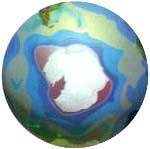|
|
|
 |
|
|
| The
ozone layer presents an
area called ozone hole in
where the concentation of
this gas reaches the lowest
levels. This area is located
on the Antarctica. |
|
|
The Earth is surrounded
by an air mass formed by several layers,
that receives the atmosphere name.
This one constitutes a true protective
shield that, when leaking certain
deadly solar radiations, makes the
life possible. The atmosphere also
provides oxygen and plays an important
role in the transport of energy, and
the heat balance between warm regions
and cold ones.
Atmospheric layers
In the terrestrial
atmosphere layers of different composition
are distinguished, that display important
variations of pressure and temperature.
The inferior layer
is the troposphere, that arrives approximately
up to 10 km of altitude, and supports
the most considerable meteorological
changes. Is in the troposphere where
the totality of the human activities
is developed. At the level of the
sea, the atmospheric pressure is around
1,000 milibars, and the temperature,
although it depends on the position
respect to the equator, usually does
not surpass 86 F. Pressure and temperature
diminish as going up in the atmosphere.
In the limits of the troposphere it
register -76 F.
Between 10 and 50
km the second atmospheric layer is
located, the stratosphere. In it an
increase of the temperature is registered,
that arrives at 32 F, by the ozone
presence, a gas that is arranged in
layer form and absorbs good part of
the originating radiations of the
deep space. The pressure continues
diminishing in the stratosphere.
The third layer
is the mesosphere, located between
the 50 and 90 km, where take place
a new cooling, registering the more
losses more losses atmospheric temperatures.
From the 90 to 400
km is located the ionosphere, thus
denominated by the electrical particle
presence of solar origin, that is
the result of ionization (dissociation
of atom oxygen molecules with electrical
energy). The temperature ascends abruptly,
until reaching the 1740 F.
|
|
|
|
| The
global Earth heating takes
place by the alteration
of the conservatory effect,
a natural and essential
phenomenon for the life
in our planet. |
|
|
The two following
layers of the atmosphere are the metasphere,
between 400 and 720 km, and the protosphere,
between 720 and 1,000 km. The atmospheric
pressure practically disappears to
720 km of altitude. In both layers
almost other gases do not exist that
hydrogen and helium. Beyond the metasphere
the deep space begins.
From the beginning
of the Industrial Revolution, by the
end of XVIII century, the human activity
has caused serious alterations in
the atmosphere.
Strange gases of
chimneys, automotive sewers of escape
of and aerosols invade it continuously
and modify their composition. This
process has given rise, fundamentally,
to three phenomena: the destruction
of the ozone layer, the effect conservatory
and acid rain.
Ozone, an effective
filter
The ozone layer
is a true filter of the dangerous
ultraviolet radiations that emits
the sun. It is composed by ozone,
a gas whose molecules contain three
oxygen atoms. If this thin strip of
our stratosphere disappeared or it
were deteriorated, the consequences
for alive beings would be catastrophic.
In first place, the phytoplankton
would be destroyed, with the consequent
alteration of the trofic chain in
the oceans, that would put in danger
all the marine organisms. In the man,
the radiations would cause serious
damages, among them, the increase
of the cases of cancer of skin, the
weakening of the immunological system
and numerous upheavals of the vision.
In 1974 it was discovered
that the clorofluorocarbon (CFC) were
the main responsable of the thinning
of the layer of this gas, that could
get to thin so much that produces
the ozone hole. The CFC are gases
that the industry uses in great amount;
for example, in the equipment of refrigeration
and like means of propulsion of the
aerosols.
Soon it was verified
that the destruction of this layer
reaches its greater levels on the
Antarctica, during the spring of the
South hemisphere. By the end of the
80´s industrial countries agreed
in Montreal, Canada, to reduce the
manufacture of CFC 50% for year 2000.
The predicted scheme began to be applied,
but neither the Conference of Rio
de Janeiro in 1992 nor the one of
Tokyo in 1997 obtained that that position
stayed inalterable. The governments
confront crescents pressures on the
part of industries that are considered
harmed directly: the reduction in
the elaboration of packages with aerosols
follows a rate much more slow now.
In addition, great resistance exists
to invest in investigation and the
adoption of new technologies.
The effect conservatory
The effect conservatory
is in a natural, normal and essential
phenomenon for the development of
the life. Its existence makes possible
that in the Earth temperatures adapted
for the survival of the alive organisms
exists. But this natural fact can
become pernicious, if it is increased
by the activity of the man.
It works like crystals
of a garden conservatory. In those
constructions, the solar radiations
penetrate through glasses and generate
heat in the interior; when the sun
is hidden, the heat does not leave
with facility, reason why the temperature
of the conservatory is remarkably
more high than the outside.
In planetary scale,
the atmosphere reflects - it is to
say, rejects, part of the solar radiations;
another part is absorbed by the own
atmosphere and, in last instance,
by the terrestrial surface, that also
rejects a part in form of infrared
radiations.
When in the high
atmosphere an obstacle exists, those
radiations do not return to the deep
space, but are retained.
As of glasses of
the conservatory, in this case that
function is acted by certain gases,
in which the infrared radiations bounce
and return to the low atmospheric
layers.
If for some reason the presence of
those gases in the atmosphere were
increased, would be more amount of
rejected infrared rays. It would produce
heat and generate a global Earth heating.
The consequences
of the effect conservatory are the
destabilization of the climate in
the planet and the melt of the ice
until now immobilized in the polar
caps. The climatic changes already
can be perceived, in form of hurricanes,
heat waves and droughts. But most
important it is that the generalized
defrosting of the polar regions would
imply an increase of the level of
the oceans, with the consequent flooding
of the low coasts of the continents.
Acid rain
The thermoelectrial
power stations and the great industrial
complexes emit nitrogen and ulphur
oxides, that react with the presence
of water steam in the air and form
nitric and ulphuric acids. Acid rain
is the result of those chemical reactions;
it consists of rainwater very contaminated,
that not necessarily hurries on such
places where it was originated. The
acidification of the ground harms
several types of farmings: the acid
water drags of the ground mineral
salts of potassium, calcium and magnesium,
necessary for the growth of the plants.
In the man, this
phenomenon is cause of different affections
in the respiratory apparatus. In the
cities acid rain causes corrosion
of buildings and monuments. Also it
dissolves toxic metals of the pipes,
as the chlorine and the lead, that
happen to the potable water.
The continent more
punished with the acid rain is Europe,
that already has severely damaged
its main forests.
|

 cargando el contenido
cargando el contenido